I was born in Greenville County, South Carolina near the foothills of the Blue Ridge Mountains, the area that is the cradle of old time and bluegrass music. We lived about 35 miles from where Earl Scruggs grew up and learned to play the banjo in Flint Hill, N.C. I can remember Bill Monroe coming to Berea, about six or eight miles from our house, to play on the radio from the grocery store there. Between shows the band would go across the road to the filling station and drink moonshine there provided by my daddy and Roy Riggins. Roy Elrod, who claimed to be Bill Monroe’s first banjo player, used to work in a barbershop over in Pickens County when he wasn’t on the road with Bill. My uncles and cousins on the Julian side of the family used to get together and play around there. My musical inspiration came from my Uncle Will Julian. When I was a little boy we used to drive over from Greenville on Sundays and visit Uncle Will and Aunt Mattie, and after dinner we would all sit out on the front porch and Uncle Will would play the banjo until way after dark. Later in life, when I finally learned to play, the first songs I learned were the old songs I first heard on Uncle Will’s front porch. Songs like “Down in Union County”, “Darling Nellie Gray”, and “Lamp Lighting Time in the Valley” |
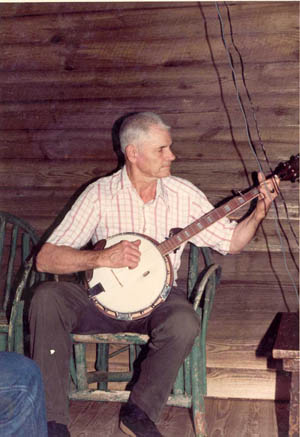 Uncle Will Julian |
I wound up in Florida to finish high school, and arrived there about the same time Ralph and Carter Stanley went to work at the radio station in Live Oak, Florida. They had a show called the “Noontime Jamboree” that I used to listen to and it was sponsored by Jim Walter Homes. I have some old vinyl that was recorded at the radio station in 1958 that has those old Jim Walter commercials on it. I have often wondered if I might have been listening to that show when it was recorded. During those same years, Jim and Jesse had a TV show on Sundays out of Tallahassee on channel 5 called the “Jim and Jesse Gospel Hour”. On Saturday nights occasionally they would come down to Perry where we lived and play at the roller skating rink. They played an afternoon and a night show and I remember them coming out to the house for supper on several occasions between shows. So, I guess I come by my love for bluegrass music naturally, it was the kind of music I loved and I was surrounded with it growing up. I came to Michigan to go to college, eventually graduating from Michigan State as an Engineer, did some post grad work at the University of Michigan, and went to work for General Motors. I always wanted a banjo when I was a kid, but it just didn’t happen. But as fate would have it, I met Wayne Fairchild at work one day. Wayne was a machinist for GM but his real passion was building and playing the banjo. Somehow I convinced Wayne to help me build a five string banjo, and that was the beginning of my career as a musician and a luthier. I only built one banjo and never did learn to play it worthwhile. I found that I could not play an instrument with five strings using three fingers and get the timing to come out 4/4. The math just didn’t work out for me. I gave the banjo to my son who became a fine banjo player and still has that banjo. This was about the time I met Mike Mckellar who became my music teacher, mentor, critic and friend. Mike, my banjo teacher, convinced me that the guitar, not the banjo, was basic if you wanted to play stringed instruments. I believed that and took guitar lessons from him. I became a decent rhythm guitar player and I still play it almost as much as the mandolin. I like to play the guitar if I am going to sing because the rhythm works out better for me (the math is right). Mac MacDermit, who had apprenticed to a classical guitar maker from Europe, helped me get started building guitars. I built two classical guitars and then switched to dreadnoughts and have built 14 to date including one for Mike McKellar. Mike and I later started the Michigan Bluegrass Association, which is still going strong. |
|
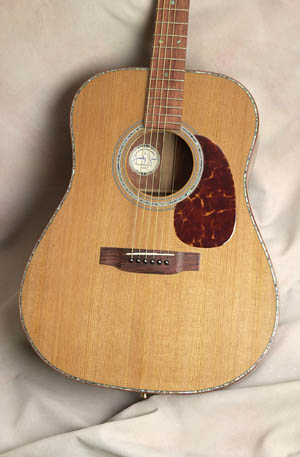 Pomelle Bubinga Guitar number 12 |
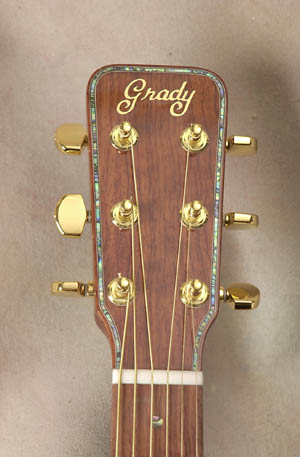 Headstock of number 12 |
The problem with playing the guitar is that there are always too many guitar pickers around and somebody winds up having to play the bass, and that is usually a guitar player. Heck, you wouldn’t expect the banjo player to do it, you can’t play one with finger picks, and you can’t play one with a fiddle bow, and the mandolin player ain’t about to carry that big ole heavy thing around. Well, I took my turn at it. I played bass with the (original from Flint Michigan) Flint River Boys for four or five years. We had some really good musicians in that band and I learned a lot from them. I enjoyed playing guitar and bass, but it just didn’t satisfy my passion for the music. |
|
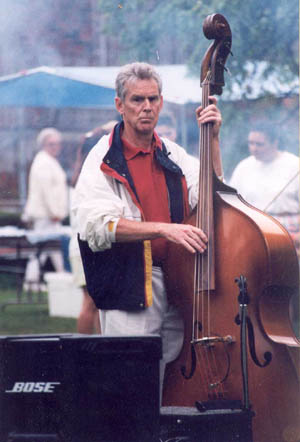 I'd rather be playing mandolin |
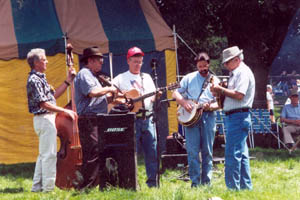 The Flint River Boys at the 4th of July picnic in Fenton |
My passion eventually led me to the fiddle and that is where my real music and luthier’s education began. Mike McKellar and his daddy, George, both played the fiddle and I guess that’s where it really got started. George taught me a few tunes and influenced my style a lot. George, who usually played in his Lazy Boy recliner, fully reclined, seldom played one string at a time. He played almost entirely with double stops. He used to say, “You can get more noise out of one that way”. I learned a lot of the old time fiddle tunes from my Uncle Norman Julian, Uncle Will’s brother who also came north to Michigan to work for GM. I studied with a real honest to goodness symphony orchestra violin player at the Flint Institute of Music for a while and actually learned to read music. My son and I did violin repair for the Flint Institute and the Flint School System for a while and that is what led me towards violin building. |
|
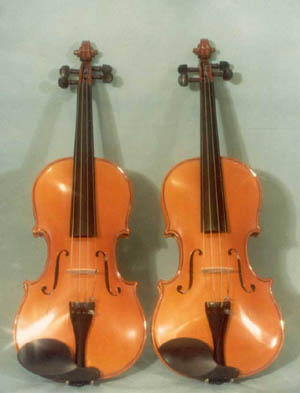 Twin fiddles Bonnie and Clyde numbers 15 and 16 |
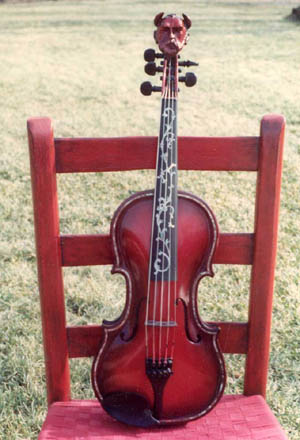 Mike McKellar's Devil Fiddle |
I apprenticed for a couple of years with an old Hungarian violinmaker named Rudy Gotschall in Reese, Michigan. Rudy taught me how to carve. I also learned from Rudy how to use sawdust and iron filings and a violin bow to vibrate the top and back plates to locate the nodes, and then where to carve to line them up to where they should be. He taught me how to graduate a top, how to tap tone, and how to blow in the f holes of the finished box and adjust the f holes to get the required air chamber (hemholtz) resonance. Rudy also claimed his mother was a gypsy and he loved gypsy fiddle music, so he taught me some of that too. At the same time I was studying with Rudy, Mike was studying for his music degree at Wayne State University and shared his knowledge of “The Fundamentals of Acoustic Music’ with me (I still have your book, Mike). I was also able to apply my knowledge of physics, vibration analysis and sound from my engineering studies to the violin. I have built 22 fiddles and it is still my favorite instrument to build. Violin building is the purest form of the luthier’s art. The violin is all wood, no plastic and no metal, the good ones are built 100% by hand and each is an individual work of art. The finish on a violin is neither art nor science but pure renaissance magic. Violin building requires a thorough understanding of the physics involved in making an acoustic stringed instrument. An understanding of violin building is fundamental to building the modern (thank you Mr. Loar) mandolin. I still play the fiddle (somewhat) but my true love is for the mandolin. I borrowed an old Martin mandolin from George McKellar to learn fiddle tunes on because it was easier to read music or tablature and play with a pick than with a bow, and the rest is history. |
|
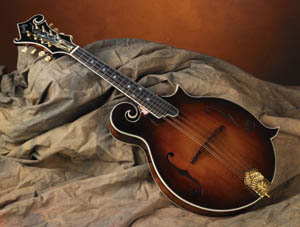 My Personal Mandolin |
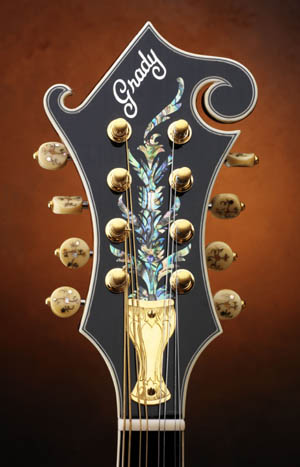 Peghead of my mandolin |
With a background of guitar and violin building I took to mandolin building like a duck to water. I also got into mandolin building at about the same time that I got involved in product development in my day job as an engineer and I applied that creative methodology to improving the mandolin. I am the proud owner of U.S. patent number US6,627,802 B1, Reinforcing braces for stringed musical instruments and method for positioning the same, which I refer to as nodal tone bars (thank you Rudy Gotschall). I have also slightly increased the air volume by using higher sides and higher arching, and have used the f holes to tune the chamber. With these and other changes in carving and graduating, I have achieved the sound that I think is perfect for the mandolin. I retired a few years ago and since then I have had a lot more time to devote to my instrument building and playing. I attend more festivals and spend a lot more time jamming with friends than I used to. I have also attended IBMA and SPBGA for the last few years and I usually have a booth there. |
|
 Come and visit me in my booth at IBMA or SPBGMA and let's jam |
 Jamming at Charlotte |
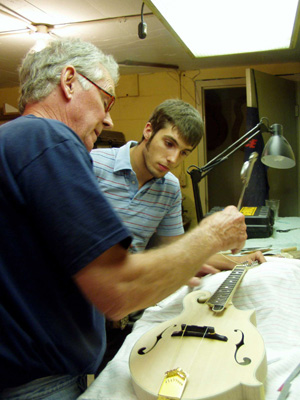 Dan and Grady |
I have been blessed over the years by having lots of people that were willing to share their time and knowledge to help me advance my instrument building skills. I try to repay that by helping others along that same path. I have taken on several students over the years and helped them build an instrument in my shop. In the gallery section of this site you will find Tony’s mandolin. Tony Segielski built that mandolin in my shop and documented it with all the photos in the How I Build ‘Em section. Tony also did all the photography for the Gallery section. I am currently working with a young man named Dan Voight who is very talented both as a player and a builder. Dan is playing his first mandolin in the white and will be starting the finishing process soon. |
I guess that in the final analysis, being an artisan of sorts, a tradesman, and an engineer, building things is just a natural thing for me to do. Building things has been my occupation, my avocation and a way to make a living. But when all the tools are put away and the shop is cleaned up and I have a little time left to do what I want, the thing I love to do best is play music, and if I can play an instrument that I have made, that just makes it that much sweeter. So I guess that is why I build instruments, and why I will probably keep on doing it. |
|
 A set of Grady instruments |
|
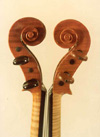 |
|
Custom Mandolins
by


